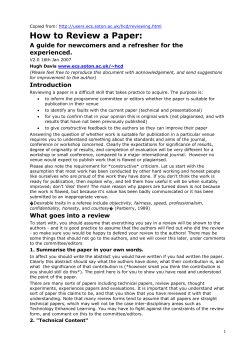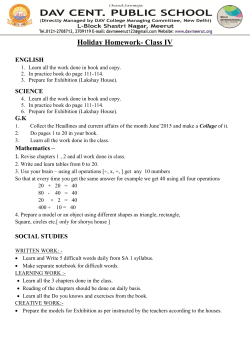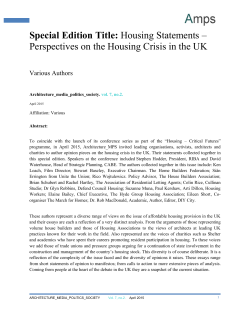
print version Rev. of Bazerman, Charles, and David
Getting the "Big Picture" on Activity and Genre Theory Peter Goggin Arizona State University Rev. of Bazerman, Charles, and David Russell. Writing Selves/Writing Societies: Research from Activity Perspectives. Perspectives on Writing. Fort Collins, Colorado: The WAC Clearinghouse and Mind, Culture, and Activity, 2002. Available online at: http://wac.colostate.edu/books/selves_societies print version No man ever steps in the same river twice, for it's not the same river and he's not the same man. (Heraclitus) The oft-quoted epigraph attributed to the pre-Socratic philosopher, Heraclitus, is representative of the self-reflection and contradiction one may experience in reading studies on activity theory. Just as Heraclitus posited the relationship between human thought and activity in the context of interactions with the natural world, so activity theory applied to writing also attempts to account for literacy practices within a broad dynamic of interactivity. Writing Selves/Writing Societies: Research from Activity Perspectives, edited by Charles Bazerman and David Russell, is a collection of such attempts. In contemporary academic and social climates where critical self-reflection is valued (and expected), one is constantly aware of the ephemeral nature of genre, perspective, situatedness, and mediation. Locating oneself and the object of one's inquiry often becomes an exercise in second guessing, backpedaling, and apologizing for one's claims, methods, and ideological grounds. In their introduction, Bazerman and Russell define "activity theory" as: A set of related approaches that view human phenomena as dynamic, in action. Human-produced artifacts such as utterances or texts, or shovels or symphonies, are not to be understood as objects themselves, but within the activities that give rise and use to them. Their meanings are found in these dynamics of human interaction. Things human exist in an evanescent world held up by focused consciousness and attention and activity. The objects created and used in action then are studied as mediating artifacts rather than things in themselves, having rules of objects. The principles by which they are formed and maintained and changed are those of activity. (1) Activity theory thus provides a way to account for such issues as genre, perspective, situatedness, and mediation through observing and locating various acts of communication within complex interactive systems of activity. In their introduction, the editors state, "Writing is alive when it is being written, read, remembered, contemplated, followed--when it is part of human activity. Otherwise it is dead on the page, devoid of meaning, devoid of influence, worthless" (1). From interdisciplinary perspectives on writing as a socially and cognitively situated activity, the authors of the collected articles draw on theories and methodologies that have their roots in Vygotsky's developmental psychology, Latour's actor/network theory, Burke's pentad, American pragmatism, linguistic discourse theory, and Bourdieu's notion of habitus, among others. Yet it is the editors themselves, Charles Bazerman and David Russell, whose work in genre and activity theory appears to have had the most profound influence on the contributors. Many of the authors use activity theory as a means to generate critical questioning and reflective analysis for practical applications in writing. Although not a direct critique on composition teaching and research, Writing Selves/Writing Societies would serve as a powerful companion to other collections such as Petraglia's (1995) Reconceiving Writing, Rethinking Writing Instruction, and Kent's (1999) Post- Process Theory: Beyond the Writing-Process Paradigm in challenging institutional myopia. The importance of Writing Selves/Writing Societies is that while human activities have become increasingly mediated through writing, little study has been made into the ways people and organizations actually use writing on a daily basis to get things done. This is particularly noteworthy in light of developments in communication technologies, and constantly evolving modern institutions of government, education, science, and commerce. Oh, and did I mention that the book is free? All 524 pages (10.5 Megs PDF) of standard print-sized pages of text can be downloaded in either HTML or PDF versions to be read either on-screen or printed out and read in hard copy form. This is one of many important scholarly resources in writing studies located at the University of Colorado's WAC Clearinghouse Website: Abstracts in HTML Abstracts in PDF Full Chapters Writing Selves/Writing Societies draws from research methods in activity theory to present a "big picture" framework that allows for reflection on what it means to research and teach written communication. Bazerman and Russell provide fourteen articles that emphasize reflexive, broad approaches to writing studies. Each article offers a particular illustration and perspective via empirical analysis of written communication as a complex set of activities that are informed by, situated in, and actively construct the contexts in which meaning is created and disseminated in time and space. The authors observe and investigate written communication in organized systems such as national banks, hospitals, corporations, and universities. The collective effect offers a "big picture" on the landscape activity theory and the means for scholars of writing to locate themselves and their work in the theoretical terrain. For example, graduate students of writing and rhetoric who may be struggling with what is arguably one of the more challenging aspects of a thesis or dissertation study (i.e., situating their research questions and methodologies within an area of scholarly inquiry) will recognize the potential of activity theory to account for multiple complementary and contradictory facets of empirical observation. Writing Selves/Writing Societies is organized into three areas: "Producing Work and the Economy," "Producing Selves in Community," and "Producing Education." Classifying contemporary written communication as a human activity thusly provides three spheres of interactivity and highlights dynamic processes of knowledge and information production and consumption as social/epistemological/situated constructs. However, while each chapter stands on its merit as an individual study, the result is more reminiscent of a collection of journal articles than a cohesive collection. A limitation of a collection that offers such a broad perspective is that the themes defined by the editors are not extensively explored. The collection only gives a taste of each of the three spheres of human activity, while each sphere clearly warrants a more fully fleshed out exploration. Still, the editors do not presume to offer more than an overview of the theoretical landscape of activity theory, and even the tastes they offer of the three spheres of activity should whet readers' appetites to crave more as the following summary of the contents suggests. While all the chapters are worthy of mention, the following examples illustrate the range and depth of contributions. In the section "Producing Work and Economy," Catherine Schryer, Lorelei Linguard, Marlee Spafford, and Kim Garwood's "Structure and Agency in Medical Case Presentations" reports on a study investigating medical case presentations as mediating tools between medical students and physicians; it examines the role such mediation plays in the negotiation of agency. The study's findings illustrate how learning the classification strategies of medical case genres has ideological consequences that may negatively affect physicians' communications with patients, e.g., constructing patient selfreporting or patient proxy reporting as untrustworthy. In the section "Producing Selves and Community," Jean Ketter and Judy Hunter's "Creating a Writer's Identity on the Boundaries of Two Communities of Practice" reports on a case study of a student who aspires to become a professional writer as she engages in writing and learning activities in two communities—academia, and public relations. The study shows the student gradually becoming aware of the power relationships involved in writing activities as she negotiates the boundaries between the two spheres of influence. The authors argue that academic learning should support the sort of self-reflexivity that would encourage students, as they engage in writing activities, to trace their own identity definitions and come to recognize the power relations they construct and encounter as they write. In the section "Producing Education," Dana Britt Lundell and Richard Beach's "Dissertation Writers' Negotiations with Competing Activity Systems" employs activity theory to examine expectations across different systems of graduate school, department, advisors, and job markets to determine variance in expectations. The study shows how students might best align themselves with those expectations in writing the dissertation. The authors suggest that in light of the double binds of conflicting systems and expectations that students find themselves in, they would best be served by advisors and mentors who would acknowledge contradictions and help graduate students to cope with them, something they argue dissertation self-help guides rarely do. The book's editors offer chapters that add to their already substantial contributions in activity theory. David Russell and co-author Arturo Yañez's "'Big Picture People Rarely Become Historians': Genre Systems and the Contradictions of General Education" synthesizes Engeström's cultural historical activity theory and North American genre systems theory to examine the specialized discourses of non-specialist activities. Charles Bazerman's "What is not Institutionally Visible Does Not Count: The Problem of Making Activity Assessable, Accountable, and Plannable" provides a detailed analysis, explanation, and practical definitions for considering problems of assessment from an activity theory perspective. Most scholars of rhetoric and writing studies will also be familiar with the previous work of many of the authors whose work appears in this collection. It is particularly interesting to see how these researchers apply activity in their areas of specialization. The following offers a brief synopsis of a few of these contributions: In her chapter titled "Intercultural Knowledge Building: The Literate Action of a Community Think Tank," Linda Flower draws on activity theory and social cognitive rhetoric to examine conflicts that are embedded in and emerge from a community think tank on urban workforce issues to ask if the literate actions and practices involved in the process can bring about significant transformative knowledge. In her chapter "Palm™ Technologies: An Activity-Theoretic Analysis of the Rapid Emergence of a New Writing Tool," Cheryl Geisler provides an activity theory account of PDAs as technologies of text and suggests that the surveillance and systematic fragmentation of management and organization in our professional lives is increasingly moving into data basing our private/domestic spheres. In "Chronotopic Lamination: Tracing the Contours of Literate Activity," Paul Prior and Jodi Shipka explore the multiple, disparate, and fluid connections of time, place, space, individuals, institutions, and mediating contexts and artifacts of literate activities, showing through a case study analysis how writers cross multiple, layered settings of home, community, and discipline. While nominally a hypertext, Writing Selves/Writing Societies functions most effectively as print text. Whether one views the text in HTML or PDF format, all chapters are formatted in standard 8.5" x 11" pages. In HTML, the chapters are formatted in continuous scroll—a bit cumbersome if one is downloading and viewing via a modem, particularly as it contains chapters that exceed 50 pages. All chapters provide links to authors' email addresses (and web sites in some cases) While a few of the authors use anchors to link to references and notes within their own documents, there are very few external links provided throughout. Given the complexity and density of some of the pieces in this book, the lack of hyperlinks is actually a blessing, allowing the reader to follow the flow of detailed lines of argument and description with limited clickable distractions. There are a few minor technical glitches or oversights. For example, in the HTML version of Russell and Yañez's chapter, some lines of text are superimposed over each other, and the link to Derek Wallace's Website comes back "not found." Ultimately, for close annotative reading purposes, it may be more effective to print out selected chapters rather than work through them on-screen. Fortunately, the publishers, authors and editors have given permission to do just that in the site's copyright notice. In all, Writing Selves/Writing Societies offers not only a collection of important interdisciplinary perspectives into written communication as human activity, but practical models of how activity and genre theory can be used to tease out new ways of understanding texts, what people do with them, and how they use them in complex networks of social/textual action. Works Cited Kent, Thomas, ed. Post-Process Theory: Beyond the Writing Process Paradigm. Carbondale and Edwardsville, IL: Southern Illinois University Press, 1999. Petraglia, Joseph, ed. Reconceiving Writing, Rethinking Writing Instruction. Mahwah, NJ: Lawrence Earlbaum, 1995. Citation Format: Goggin, Peter. "Getting the 'Big Picture' on Activity and Genre Theory." Rev. of Writing Selves/Writing Societies, eds. D Russell and C. Bazerman. Enculturation 5.2 (2004): http://enculturation.gmu.edu/5_2/goggin.html Contact Information: Peter Goggin, Arizona State University Email: petergo@asu.edu Home Page: http://www.public.asu.edu/~petergo Home | About | Editors | Issues Submissions | Subscribe | Copyright | Review | Links
© Copyright 2025










